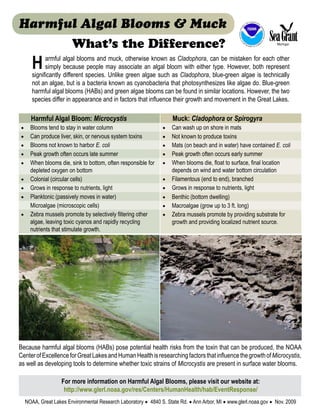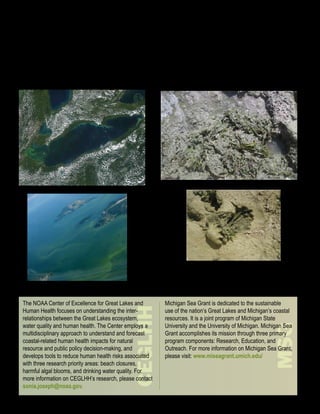Harmful Algal Blooms and Muck: What's the Difference?
- 1. Harmful Algal Blooms & Muck IC AN D AT MOSPH ER IC N AD EA MI C N IS IO N A L O T R A T IO N What’s the Difference? NATU. CE D S. EP R E AR TME O MM NT OF C H armful algal blooms and muck, otherwise known as Cladophora, can be mistaken for each other simply because people may associate an algal bloom with either type. However, both represent significantly different species. Unlike green algae such as Cladophora, blue-green algae is technically not an algae, but is a bacteria known as cyanobacteria that photosynthesizes like algae do. Blue-green harmful algal blooms (HABs) and green algae blooms can be found in similar locations. However, the two species differ in appearance and in factors that influence their growth and movement in the Great Lakes. Harmful Algal Bloom: Microcystis Muck: Cladophora or Spirogyra ◆ Blooms tend to stay in water column ◆ Can wash up on shore in mats ◆ Can produce liver, skin, or nervous system toxins ◆ Not known to produce toxins ◆ Blooms not known to harbor E. coli ◆ Mats (on beach and in water) have contained E. coli ◆ Peak growth often occurs late summer ◆ Peak growth often occurs early summer ◆ When blooms die, sink to bottom, often responsible for ◆ When blooms die, float to surface, final location depleted oxygen on bottom depends on wind and water bottom circulation ◆ Colonial (circular cells) ◆ Filamentous (end to end), branched ◆ Grows in response to nutrients, light ◆ Grows in response to nutrients, light ◆ Planktonic (passively moves in water) ◆ Benthic (bottom dwelling) Microalgae (microscopic cells) ◆ Macroalgae (grow up to 3 ft. long) ◆ Zebra mussels promote by selectively filtering other ◆ Zebra mussels promote by providing substrate for algae, leaving toxic cyanos and rapidly recycling growth and providing localized nutrient source. nutrients that stimulate growth. Because harmful algal blooms (HABs) pose potential health risks from the toxin that can be produced, the NOAA Center of Excellence for Great Lakes and Human Health is researching factors that influence the growth of Microcystis, as well as developing tools to determine whether toxic strains of Microcystis are present in surface water blooms. For more information on Harmful Algal Blooms, please visit our website at: http://www.glerl.noaa.gov/res/Centers/HumanHealth/hab/EventResponse/ NOAA, Great Lakes Environmental Research Laboratory ◆ 4840 S. State Rd. ◆ Ann Arbor, MI ◆ www.glerl.noaa.gov ◆ Nov. 2009
- 2. Microcystis blooms are suspended in surface water and can Cladophora blooms have been found in various areas of give water a green appearance. Microcystis blooms have the Great Lakes, including western Lake Michigan and the been found in western Lake Erie, Saginaw Bay, western Saginaw Bay area of Lake Huron in Michigan. Cladophora Lake Michigan, and inland tributaries of Lake Michigan. mats wash up on shorelines from the bottom of water bodies They do not typically wash up on shorelines or leave a slimy in the summer months and can be considered a nuisance to residue on shores or boats (but in some instances have), local communities. Cladophora blooms create a “muck” zone however, Microcystis is capable of producing the toxin on beaches and have the potential to harbor bacteria, but do microcystin, which poses potential health threats. The toxin not produce algal toxins. may be present in the water even after the bloom subsides. Algae blooms in western Lake Erie as shown from a MODIS satellite photo (top left) taken on August 13, 2009, and from an airplane (bottom left) taken on August 11, 2009 (photo from J. Lekki, NASA Glenn Research Center). Shoreline muck in Saginaw Bay, Lake Huron in September 2006. Digging below the surface reveals vegetation underneath. The NOAA Center of Excellence for Great Lakes and Michigan Sea Grant is dedicated to the sustainable CEGLHH Human Health focuses on understanding the inter- use of the nation’s Great Lakes and Michigan’s coastal relationships between the Great Lakes ecosystem, resources. It is a joint program of Michigan State water quality and human health. The Center employs a University and the University of Michigan. Michigan Sea MSG multidisciplinary approach to understand and forecast Grant accomplishes its mission through three primary coastal-related human health impacts for natural program components: Research, Education, and resource and public policy decision-making, and Outreach. For more information on Michigan Sea Grant, develops tools to reduce human health risks associated please visit: www.miseagrant.umich.edu/ with three research priority areas: beach closures, harmful algal blooms, and drinking water quality. For more information on CEGLHH’s research, please contact sonia.joseph@noaa.gov.


